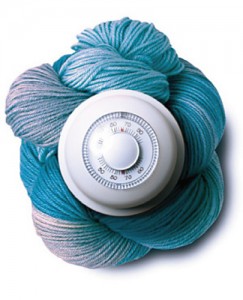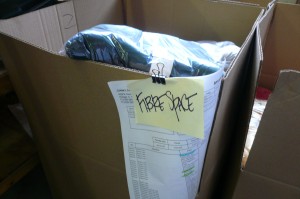
The shop is stuffed with new Lorna’s Laces Sportmate in a glorious array of colors. We caught up with Beth Casey, the mastermind behind Lorna’s, recently to find out how she keeps the color and the fibre of Lorna’s fresh and fantastic. Read on as Beth tells us about LL’s gorgeous colorways, their new yarn and more!
Q: Could you give us some background about Lorna’s Laces? How did you wind up buying the company from Lorna?
A: I guess restlessness and curiosity is what inspired my journey. Here’s a little of the back story of how Lorna’s Laces and I found each other.
Lorna Miser started Lorna’s Laces in her kitchen about twenty years ago. She lived in a rural area of northern California and raised sheep and goats. At first she was spinning fiber from her own animals for her own use. Then she decided to dye some of the yarn to see if she could sell it at the local farmer’s market. The dyeing was so successful that she soon needed to start buying yarn rather than spinning it herself. The next thing she knew, her yarns were being sold at a local shop. Then another and another.
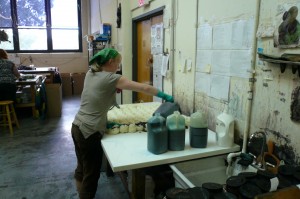
Over the years, her business grew. She started going to trade shows and gaining a reputation. Her company was growing up. But something deep down was tugging at her. Design was really her first love and, with four teenagers at home, she found herself unable to spend the time on it she wanted to. So, she decided it was time to sell Lorna’s Laces and follow her muse.
At the same time, I found myself in Chicago facing some big decisions. I’d worked in college textbook publishing for 11 years. It was a great job for a long time, but after a while I found myself growing restless. My unhappiness got so bad that one morning as I was starting my daily ritual of whining and complaining, my husband stopped me and said “I’ve had enough. One of us is going to call your boss today to tell him you are resigning. Do you want to do it or shall I?” So I put on my big-girl pants and made the call. I spent the next couple of years bouncing around, trying to figure out what to do next. I studied bread baking at the French Culinary Institute in New York. I walked dogs; I watched way too much daytime TV.
One evening, I was thumbing through a knitting magazine and noticed a small ad in the back. You know, those little half-inch want ads? It said something about a hand-dyed yarn company being for sale. And it mentioned that it could be relocated. So, I emailed for more information. That was in August 2002. I flew out to meet Lorna Miser and see her studio in October. We negotiated the terms of the sale over the next several weeks and I was introduced as the new owner of Lorna’s Laces at TNNA in January 2003.
Lorna has been happily designing sweaters, teaching classes and writing books ever since. I’ve found a creative space that calms my restlessness and feeds my curiosity. And I get to make pretty string every day.
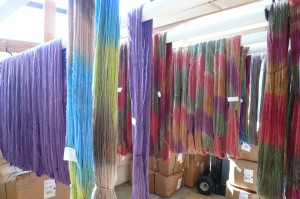
Q. Where does your fiber come from?
A. Our fiber comes from all over the world. We get wool from New Zealand, Australia, Argentina and South Africa. Angora from France. Our mohair comes from South Africa as well. Some of our yarns are milled domestically and some of them overseas.
Q. Where is it dyed?
A. All of our yarn is dyed right here in our studio in Chicago. We’re a stone’s throw from Wrigley Field in a neighborhood called Ravenswood.
Q. How do you make sure the yarn is the high quality you want it to be?
A. I’m really conservative when it comes to buying yarn. I have long-term relationships with people and mills I trust and I don’t make moves quickly. I believe that it’s more important to provide a consistent, high quality yarn that stitchers can rely on rather than trying to economize by moving from mill to mill.
Q. What inspires your yarns?
A. I live in a very special world. First, mills and their reps contact me with yarns or fibers that they think I might be interested in. If something piques my interest, a fiber or construction perhaps, we start to explore it further. Maybe we’ll make a different weight or change up the number of plies. My first criteria is always “Would I want to knit with it?” or “What do I want to knit with that I can’t find right now?” That’s kind of true of color too.
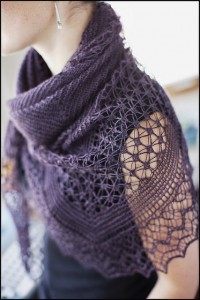
Q. How do you come up with your amazing colorways?
A. I look to the world all around me for inspiration for colorways. Sometimes it’s as simple as really seeing that terracotta pot full of mums sitting on the neighbor’s front porch. How would the oranges, yellows and greens play off one another? [That turned into Glenwood.] Or going to buy new bath towels and instead of walking into the department store and making a beeline for the green I need, I’ll step back and consider how some of the colors on that big display wall might dance together. [That idea became Tahoe.] I try and keep my eyes and heart open and pay attention to my surroundings. What about the color of the sky when that crazy storm came through a couple of weeks ago? Or the way the concrete looks after a rain? Sometimes it’s just silliness, like what would a Zombie BBQ look like? Or a Unicorn Parade?
Q. What’s one of your favorite patterns for Helen’s Lace?
A. Brooklyn Tweed’s Rock Island Shawl takes my breath away.
Q. What is something you’d like us to know about LL that most people don’t?
- We’ve got a bunch of new going on right now and you’ll be seeing more in the coming weeks and months.
- We’re busy dyeing nine new colors that are named for Chicago landmarks. Think Magnificent Mile, The “L”, The Outer Drive, etc.
- The last bit of new is our new sock yarn, Solemate (and Sportmate!) It’s a nifty blend of superwash merino, nylon and Outlast. Outlast is this fantastic fiber that moderates your temperature. It was designed for the space program. The story behind Solemate is kind of fun. Someone brought the idea to me almost two years ago. I was intrigued by the whole high-tech thing, but still not sure. I mulled and dithered and finally decided to have a small test batch made. I put the samples in the hands of a bunch of designers to see what they thought. I got a great response. Janel Laidman asked me if I had enough to supply her sock club right away. Sandi Rosner told me she loved it. But Anne Hanson clinched the deal. She told me how much she liked the way the yarn felt in her hands while she worked with it. That it made a beautiful fabric…it had the tiniest bit of sheen and that it felt a little dressy. Anne didn’t talk about high tech and space; she talked about the things all knitters talk about when they talk about yarn: the hand, the appearance. So, maybe we married high tech and tradition. Wouldn’t that be fun?
